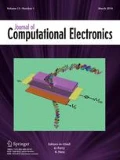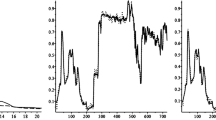Abstract
A basis-adaptation method based on polynomial chaos expansion is used for the stochastic nonlinear Poisson–Boltzmann equation. The uncertainty in this numerical approach is motivated by the quantification of noise and fluctuations in nanoscale field-effect sensors. The method used here takes advantage of the properties of the nonlinear Poisson–Boltzmann equation and shows an exact and efficient approximation of the real solution. Numerical examples are motivated by the quantification of noise and fluctuations in nanowire field-effect sensors as a concrete example. Basis adaptation is validated by comparison with the full solution, and it is compared to optimized multi-level Monte-Carlo method, and the model equations are validated by comparison with experiments. Finally, various design parameters of the field-effect sensors are investigated in order to maximize the signal-to-noise ratio.








Similar content being viewed by others
References
Alexander, C., Roy, G., Asenov, A.: Random-dopant-induced drain current variation in nano-MOSFETs: a three-dimensional self-consistent Monte Carlo simulation study using “ab initio” ionized impurity scattering. IEEE Trans. Electron Devices 55(11), 3251–3258 (2008)
Barth, A., Schwab, C., Zollinger, N.: Multi-level Monte Carlo finite element method for elliptic PDEs with stochastic coefficients. Numer. Math. 119(1), 123–161 (2011)
Baumgartner, S., Heitzinger, C.: Existence and local uniqueness for 3D self-consistent multiscale models for field-effect sensors. Commun. Math. Sci 10(2), 693–716 (2012)
Baumgartner, S., Heitzinger, C.: A one-level FETI method for the drift-diffusion-Poisson system with discontinuities at an interface. J. Comput. Phys. 243, 74–86 (2013). doi:10.1016/j.jcp.2013.02.043
Baumgartner, S., Heitzinger, C., Vacic, A., Reed, M.A.: Predictive simulations and optimization of nanowire field-effect PSA sensors including screening. Nanotechnology 24(22), 225503 (2013)
Brunet, E., Maier, T., Mutinati, G., Steinhauer, S., Köck, A., Gspan, C., Grogger, W.: Comparison of the gas sensing performance of SnO\(_{2}\) thin film and SnO\(_{2}\) nanowire sensors. Sens. Actuators B 165(1), 110–118 (2012)
Bulyha, A., Heitzinger, C.: An algorithm for three-dimensional Monte-Carlo simulation of charge distribution at biofunctionalized surfaces. Nanoscale 3(4), 1608–1617 (2011)
Chen, D., Wei, G.W.: Modeling and simulation of electronic structure, material interface and random doping in nano-electronic devices. J. Comput. Phys. 229(12), 4431–4460 (2010)
Cliffe, K., Giles, M., Scheichl, R., Teckentrup, A.L.: Multilevel Monte Carlo methods and applications to elliptic PDEs with random coefficients. Comput. Vis. Sci. 14(1), 3–15 (2011)
Cui, Y., Wei, Q., Park, H., Lieber, C.M.: Nanowire nanosensors for highly sensitive and selective detection of biological and chemical species. Science 293(5533), 1289–1292 (2001)
Doostan, A., Ghanem, R.G., Red-Horse, J.: Stochastic model reduction for chaos representations. Comput. Methods Appl. Mech. Eng. 196(37), 3951–3966 (2007)
Duan, X., Li, Y., Rajan, N.K., Routenberg, D.A., Modis, Y., Reed, M.A.: Quantification of the affinities and kinetics of protein interactions using silicon nanowire biosensors. Nat. Nanotechnol. 7(6), 401–407 (2012)
Eldred, M., Burkardt, J.: Comparison of non-intrusive polynomial chaos and stochastic collocation methods for uncertainty quantification. In: Proc. 47th AIAA Aerospace Sciences Meeting, vol. 976, pp. 1–20 (2009)
Giles, M.: Improved multilevel Monte Carlo convergence using the Milstein scheme. Monte Carlo and Quasi-Monte Carlo Methods 2006, pp. 243–258. Springer, Berlin (2008)
Hahm, J., Lieber, C.M.: Direct ultrasensitive electrical detection of DNA and DNA sequence variations using nanowire nanosensors. Nano Lett. 4(1), 51–54 (2004)
Hassibi, A., Navid, R., Dutton, R., Lee, T.: Comprehensive study of noise processes in electrode electrolyte interfaces. J. Appl. Phys. 96(2), 1074–1082 (2004)
Heitzinger, C., Liu, Y., Mauser, N.J., Ringhofer, C., Dutton, R.W.: Calculation of fluctuations in boundary layers of nanowire field-effect biosensors. J. Comput. Theor. Nanosci. 7(12), 2574–2580 (2010)
Heitzinger, C., Mauser, N.J., Ringhofer, C.: Multiscale modeling of planar and nanowire field-effect biosensors. SIAM J. Appl. Math. 70(5), 1634–1654 (2010)
Heitzinger, C., Ringhofer, C.: Multiscale modeling of fluctuations in stochastic elliptic PDE models of nanosensors. Commun. Math. Sci. 12(3), 401–421 (2014). doi:10.4310/CMS.2014.v12.n3.a1
Köck, A., Tischner, A., Maier, T., Kast, M., Edtmaier, C., Gspan, C., Kothleitner, G.: Atmospheric pressure fabrication of SnO\(_{2}\)-nanowires for highly sensitive CO and CH\(_{4}\) detection. Sens. Actuators B 138(1), 160–167 (2009)
Kulkarni, G.S., Zhong, Z.: Detection beyond the Debye screening length in a high-frequency nanoelectronic biosensor. Nano Lett. 12(2), 719–723 (2012)
Laborde, C., Pittino, F., Verhoeven, H., Lemay, S., Selmi, L., Jongsma, M., Widdershoven, F.: Real-time imaging of microparticles and living cells with nanocapacitor arrays. Nat. Nanotechnol. 10, 791–795 (2015)
Lee, A., Brown, A.R., Asenov, A., Roy, S.: Random telegraph signal noise simulation of decanano MOSFETs subject to atomic scale structure variation. Superlattices Microstruct. 34(3), 293–300 (2003)
Liu, Y., Lilja, K., Heitzinger, C., Dutton, R.W.: Overcoming the screening-induced performance limits of nanowire biosensors: a simulation study on the effect of electro-diffusion flow. In: IEDM 2008 Technical Digest, pp. 491–494. San Francisco, CA (2008). doi:10.1109/IEDM.2008.4796733
Markowich, P., Ringhofer, C., Schmeiser, C.: Semiconductor. Springer, Wien (1990)
Patolsky, F., Timko, B.P., Yu, G., Fang, Y., Greytak, A.B., Zheng, G., Lieber, C.M.: Detection, stimulation, and inhibition of neuronal signals with high-density nanowire transistor arrays. Science 313(5790), 1100–1104 (2006)
Patolsky, F., Zheng, G., Lieber, C.M.: Fabrication of silicon nanowire devices for ultrasensitive, label-free, real-time detection of biological and chemical species. Nat. Protoc. 1(4), 1711–1724 (2006)
Pittino, F., Selmi, L.: Use and comparative assessment of the CVFEM method for Poisson–Boltzmann and Poisson–Nernst–Planck three dimensional simulations of impedimetric nano-biosensors operated in the DC and AC small signal regimes. Comput. Methods Appl. Mech. Eng. 278, 902–923 (2014)
Pittino, F., Palestri, P., Scarbolo, P., Esseni, D., Selmi, L.: Models for the use of commercial TCAD in the analysis of silicon-based integrated biosensors. Solid-State Electron. 98, 63–69 (2014)
Pittino, F., Passerini, F., Selmi, L., Widdershoven, F.: Numerical simulation of the position and orientation effects on the impedance response of nanoelectrode array biosensors to DNA and PNA strands. Microelectron. J. 45(12), 1695–1700 (2014)
Ponzoni, A., Comini, E., Sberveglieri, G., Zhou, J., Deng, S.Z., Xu, N.S., Ding, Y., Wang, Z.L.: Ultrasensitive and highly selective gas sensors using three-dimensional tungsten oxide nanowire networks. Appl. Phys. Lett. 88(20), 203,101 (2006)
Punzet, M., Baurecht, D., Varga, F., Karlic, H., Heitzinger, C.: Determination of surface concentrations of individual molecule-layers used in nanoscale biosensors by in situ ATR-FTIR spectroscopy. Nanoscale 4(7), 2431–2438 (2012)
Rajan, N.K., Routenberg, D.A., Reed, M.A.: Optimal signal-to-noise ratio for silicon nanowire biochemical sensors. Appl. Phys. Lett. 98(26), 264,107 (2011)
Stern, E., Klemic, J.F., Routenberg, D.A., Wyrembak, P.N., Turner-Evans, D.B., Hamilton, A.D., LaVan, D.A., Fahmy, T.M., Reed, M.A.: Label-free immunodetection with CMOS-compatible semiconducting nanowires. Nature 445(7127), 519–522 (2007)
Stern, E., Vacic, A., Rajan, N.K., Criscione, J.M., Park, J., Ilic, B.R., Mooney, D.J., Reed, M.A., Fahmy, T.M.: Label-free biomarker detection from whole blood. Nat. Nanotechnol. 5(2), 138–142 (2010)
Tipireddy, R., Ghanem, R.: Basis adaptation in homogeneous chaos spaces. J. Comput. Phys. 259, 304–317 (2014)
Tulzer, G., Baumgartner, S., Brunet, E., Mutinati, G.C., Steinhauer, S., Köck, A., Barbano, P.E., Heitzinger, C.: Kinetic parameter estimation and fluctuation analysis of CO at SnO\(_{2}\) single nanowires. Nanotechnology 24(31), 315501 (2013)
Tulzer, G., Heitzinger, C.: Fluctuations due to association and dissociation processes at nanowire-biosensor surfaces and their optimal design. Nanotechnology 26(2), 025502 (2015). doi:10.1088/0957-4484/26/2/025502
Uren, M., Day, D., Kirton, M.: 1/f and random telegraph noise in silicon metal-oxide-semiconductor field-effect transistors. Appl. Phys. Lett. 47(11), 1195–1197 (1985)
Wang, C., Yin, L., Zhang, L., Xiang, D., Gao, R.: Metal oxide gas sensors: sensitivity and influencing factors. Sensors 10(3), 2088–2106 (2010)
Xiu, D., Karniadakis, G.E.: The Wiener–Askey polynomial chaos for stochastic differential equations. SIAM J. Sci. Comput. 24(2), 619–644 (2002)
Zheng, G., Patolsky, F., Cui, Y., Wang, W.U., Lieber, C.M.: Multiplexed electrical detection of cancer markers with nanowire sensor arrays. Nat. Biotechnol. 23(10), 1294–1301 (2005)
Acknowledgments
The authors acknowledge the support by FWF (Austrian Science Fund) START Project No. Y660 PDE Models for Nanotechnology. The authors also would like to appreciate Prof. Roger Ghanem (University of Southern California) for useful discussions about polynomial chaos expansion.
Author information
Authors and Affiliations
Corresponding author
Rights and permissions
About this article
Cite this article
Khodadadian, A., Heitzinger, C. Basis adaptation for the stochastic nonlinear Poisson–Boltzmann equation. J Comput Electron 15, 1393–1406 (2016). https://doi.org/10.1007/s10825-016-0922-2
Published:
Issue Date:
DOI: https://doi.org/10.1007/s10825-016-0922-2




